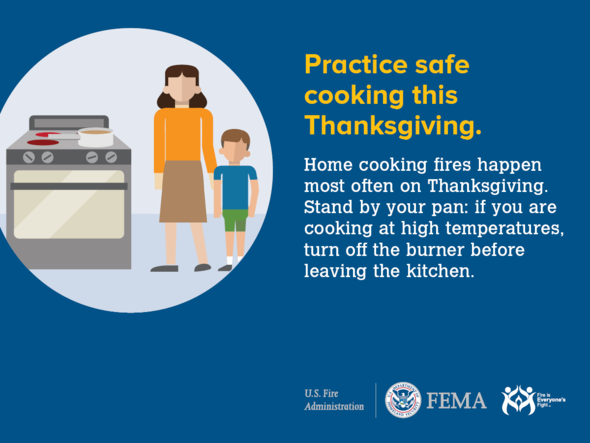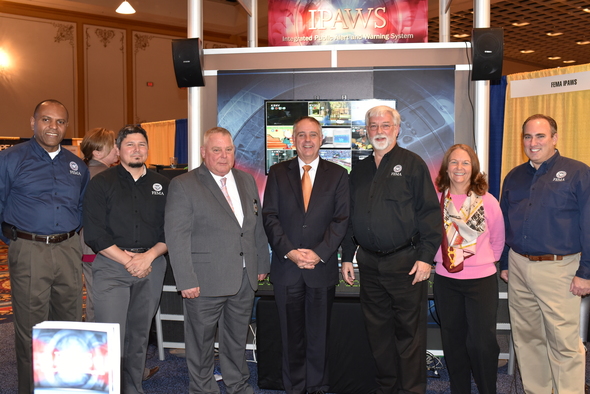|
Thanksgiving is the peak day
for home cooking fires. For each year from 2011 to 2013, an estimated 2,100
residential building fires were reported to fire departments in the United States on
Thanksgiving Day, and caused an estimated 10 deaths, 50 injuries, and $28 million
in property loss.
It is important to stay in the kitchen when cooking at
high temperatures, particularly when frying, broiling, or boiling. Frying food is the greatest risk of cooking fires. Two-thirds
of home cooking fires start when food or cooking materials catch on fire, and more
than half of home cooking fire injuries happen when people try to fight the
fire themselves.
If frying a turkey this Thanksgiving, remember these
facts:
- Turkey fryers can easily tip over, spilling hot cooking
oil over a large area.
- An overfilled cooking pot will cause cooking oil to
spill when the turkey is put in, and a partially frozen turkey will cause
cooking oil to splatter when put in the pot.
- Even a small amount of cooking oil spilling on a hot
burner can cause a large fire.
- Without thermostat controls, deep fryers can overheat
oil to the point of starting a fire.
- The sides of the cooking pot, lid and pot handles can
get dangerously hot.
Visit the U.S. Fire Administration website at www.usfa.fema.gov for more information on cooking and turkey fryer safety.

FEMA and partners will hold the Fifth Annual Building
Resilience through Public-Private Partnerships Conference on
December 10-11, 2015 in New Orleans, Louisiana. The
events of 9/11, Hurricane Katrina, and the continued threat environment have forged
strong public-private partnerships that have enhanced prevention, protection,
response, recovery, and mitigation for all-hazards resilience with
acknowledgement across the board that there is more to be done.
The conference brings together industry
executives and government and nonprofit leadership from across the emergency
management and homeland security enterprise. For those interested in
participating in the in person conference there is still time to register. For more information and to check out
the conference agenda visit www.dhs.gov/event/Public-Private-Partnerships-Conference.
Sponsored
this year by FEMA, in partnership with the
U.S. Department of Homeland Security through the National Protection and
Programs Directorate and Private Sector Office, and North American Aerospace
Defense Command and U.S. Northern Command. Planned in collaboration
with: American Logistics Aid Network (ALAN), American Red Cross, Business
Executives for National Security (BENS), Business Forward, National Incident
Management Systems & Advanced Technologies, University of Louisiana at
Lafayette, The U.S. Chamber of Commerce, and The U.S. Chamber of Commerce
Foundation.
On Tuesday, November 17 at 1:20 p.m. PST, FEMA's Integrated
Public Alert and Warning System (IPAWS), in voluntary coordination with state
broadcaster associations, emergency management agencies, and state emergency
communications committee chairs from Arizona, Minnesota, Nevada, New Mexico,
Utah, and Wisconsin, issued the first bilingual alert message via the Emergency
Alert System (EAS) from the International Association of Emergency Managers
(IAEM) conference exhibit hall. A full message text and true voice spoken word
audio message was sent, received, and broadcast by participating broadcast
stations in both English and Spanish, demonstrating the capacity to convey
multilingual public alerts and warnings to the diverse communities served.
FEMA Deputy Administrator Joseph Nimmich and John “Rusty” Russell,
president of IAEM-USA, pushed the button to activate the IPAWS
Supported State/Regional Tests (ISSRT). A minute after initiating the test,
more than 1,400EAS devices in the six-state area retrieved the message. Information
included the expanded alert text, plus audio in both languages. Some stations
automatically aired the Spanish version, followed by the English version, while
others stations coupled with specific software, enabled specific language
selections for each individual program stream.
Looking to 2016, FEMA plans to continue regional National
Periodic Tests (NPT) throughout the first half of the year. New Federal
Communications Commission rules regarding EAS participant action upon receipt
of an NPT message will go into effect July 30, 2016. For more information about
IPAWS, visit www.fema.gov/ipaws.
 Left to right: Charles McCobb, IPAWS; Mark Lucero, IPAWS; John “Rusty” Russell, president of IAEM-USA; Joseph Nimmich, FEMA Deputy Administrator; Al Kenyon, IPAWS; Alisa Jones, OASIS Emergency Management Technical Committee; and Wade Witmer, IPAWS.
FEMA's Emergency Management
Institute, in partnership with the DHS Office of Academic Engagement, FEMA
Region VII, and U.S. Fire Administration, will present a webinar titled
"Tools for Creating Campus Resilience" on December 16 from 1:30-2:30
p.m. ET. The webinar will discuss ReadyCampus, the
DHS Campus Resilience Pilot Program for Colleges and Universities. This student-centered
program brings together many prominent organizations, private sector, and local
volunteer organizations to teach general preparedness to students and staff, and
the U.S. Fire Administration's Campus Fire Safety Program. Natural, technological,
and health hazards can all affect daily campus operations. Institutions are
encouraged to regularly review, update, and exercise their emergency plans.
Participants should register
in advance for the online webinar. Closed captioning will be provided.
FEMA’s Federal Insurance
and Mitigation Administration released FEMA’s Leadership
Intent to implement the Federal Flood Risk Management Standard (FFRMS). The
Intent describes the framework FEMA is proposing to implement for Executive
Order (E.O.) 13690 and the Federal Flood Risk Management Standard.
E.O. 13690 provides
federal agencies flexibility to choose from one or more approaches to identify
an elevation requirement above the base flood elevation. Additionally,
E.O. 13690 amended E.O. 11988 to set forth a higher level of resilience for
activities where even a slight chance of flooding is too great. The Intent
outlines FEMA’s approach to standardize its use of the multiple elevation
requirements above the base flood elevation.
Continuing our
commitment to an open, collaborative, stakeholder-focused process in
implementing the FFRMS, FEMA is sharing this framework for public comment on
FEMA’s website. Public comments received will continue to inform the regulatory
and policy development process.
For more information,
visit
www.fema.gov/federal-flood-risk-management-standard-ffrms or send
comments by December 17, 2015, to FEMA-EO11988-13690@fema.dhs.gov.
FEMA
is seeking public comment on proposed changes to regulation describing FEMA’s
Individual Assistance (IA) declarations criteria. FEMA published the proposed
rule in the Federal
Register, and is seeking comments by January 11, 2016.
The Sandy Recovery Improvement Act (SRIA) requires FEMA to review, update and revise,
through rulemaking, the factors it uses to measure the severity, magnitude, and
impact of a disaster. The proposed rule, which has a 60 day public
comment period, is intended to provide more objective and clear IA declaration factors and speed the declaration process,
including FEMA’s recommendation to the President on whether a major disaster
declaration authorizing IA is warranted.
The proposed rule largely expands and clarifies
current factors and aligns them with the data presently collected to support
the evaluation process and adds additional data sets easily accessible by states.
FEMA reviewed the current factors and the proposed rule intends to revise the
current factors by including: State Fiscal Capacity and Resource Availability,
Uninsured Home and Personal Property Losses, Disaster Impacted Population
Profile, Impact to Community Infrastructure, Casualties, and Disaster Related Unemployment.
Comments are due on January 11, 2016, and can be submitted
online.
|